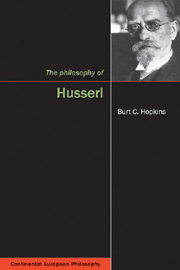Book contents
- Frontmatter
- Contents
- Acknowledgements
- Abbreviations
- Prolegomenon: Husserl's turn to history and pure phenomenology
- I Plato's and Aristotle's theory of eidē
- II From descriptive psychology to transcendentally pure phenomenology
- 4 Origin of the task of pure phenomenology
- 5 Pure phenomenology and Platonism
- 6 Pure phenomenology as the transcendental-phenomenological investigation of absolute consciousness
- 7 Transcendental phenomenology of absolute consciousness and phenomenological philosophy
- 8 Limits of the transcendental-phenomenological investigation of pure consciousness
- III From the phenomenology of transcendental consciousness to that of monadological intersubjectivity
- IV From monadological intersubjectivity to the historical a priori constitutive of all meaning
- V The unwarranted historical presuppositions guiding the fundamental ontological and deconstructive criticisms of transcendental philosophy
- Epilogue: Transcendental-phenomenological criticism of the criticism of phenomenological cognition
- Coda: Phenomenological self-responsibility and the singularity of transcendental philosophy
- Notes
- Bibliography
- Index
4 - Origin of the task of pure phenomenology
from II - From descriptive psychology to transcendentally pure phenomenology
- Frontmatter
- Contents
- Acknowledgements
- Abbreviations
- Prolegomenon: Husserl's turn to history and pure phenomenology
- I Plato's and Aristotle's theory of eidē
- II From descriptive psychology to transcendentally pure phenomenology
- 4 Origin of the task of pure phenomenology
- 5 Pure phenomenology and Platonism
- 6 Pure phenomenology as the transcendental-phenomenological investigation of absolute consciousness
- 7 Transcendental phenomenology of absolute consciousness and phenomenological philosophy
- 8 Limits of the transcendental-phenomenological investigation of pure consciousness
- III From the phenomenology of transcendental consciousness to that of monadological intersubjectivity
- IV From monadological intersubjectivity to the historical a priori constitutive of all meaning
- V The unwarranted historical presuppositions guiding the fundamental ontological and deconstructive criticisms of transcendental philosophy
- Epilogue: Transcendental-phenomenological criticism of the criticism of phenomenological cognition
- Coda: Phenomenological self-responsibility and the singularity of transcendental philosophy
- Notes
- Bibliography
- Index
Summary
The descriptive psychological formation of the concept of number
Husserl's pure phenomenology is driven by the goal of making philosophy a rigorous science. By “science” he understood a method of research capable of generating possible true and false propositions on the basis of evidence. By “rigorous” science he understood a science that had advanced to the point of being in the possession of a methodology whose basic concepts and criteria for distinguishing true from false propositions were sufficiently demonstrated to permit an ongoing research agenda available to and embraced by a community of researchers. And by “evidence” he understood the legitimizing source of scientific and philosophical concepts in an experience more original than, but nevertheless related to, their conceptuality. The signal importance of this goal in Husserl's formulation of pure phenomenology cannot be overestimated at any stage of its development. It composes both the most basic intention of his thought and the standard by which he measures the success or failure of its development at any given time.
Husserl did not originally set out to establish a new science whose status as rigorous science would lead to a reform of philosophy. His initial goal was the more modest one of clarifying the most basic concept of arithmetic, number, within the context of a pre-existing philosophical method, that of his teacher Franz Brentano. Brentano's method sought to account for the formation of concepts on the basis of their origin from what appears to perception.
- Type
- Chapter
- Information
- The Philosophy of Husserl , pp. 83 - 95Publisher: Acumen PublishingPrint publication year: 2010

